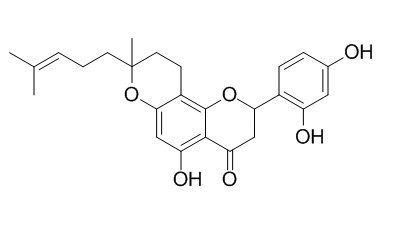Sanggenol L
Sanggenol L shows higher cytotoxicity against human oral tumor cell lines (HSC-2 and HSG) than against normal human gingival fibroblasts (HGF), it induces apoptosis via caspase activation and inhibition of NF-κB/IκBα phosphorylation as a potent chemotherapeutic agent for ovarian cancers.
Inquire / Order:
manager@chemfaces.com
Technical Inquiries:
service@chemfaces.com
Tel:
+86-27-84237783
Fax:
+86-27-84254680
Address:
1 Building, No. 83, CheCheng Rd., Wuhan Economic and Technological Development Zone, Wuhan, Hubei 430056, PRC
Providing storage is as stated on the product vial and the vial is kept tightly sealed, the product can be stored for up to
24 months(2-8C).
Wherever possible, you should prepare and use solutions on the same day. However, if you need to make up stock solutions in advance, we recommend that you store the solution as aliquots in tightly sealed vials at -20C. Generally, these will be useable for up to two weeks. Before use, and prior to opening the vial we recommend that you allow your product to equilibrate to room temperature for at least 1 hour.
Need more advice on solubility, usage and handling? Please email to: service@chemfaces.com
The packaging of the product may have turned upside down during transportation, resulting in the natural compounds adhering to the neck or cap of the vial. take the vial out of its packaging and gently shake to let the compounds fall to the bottom of the vial. for liquid products, centrifuge at 200-500 RPM to gather the liquid at the bottom of the vial. try to avoid loss or contamination during handling.
Indian Journal of Science and Technology2023, 16(SP1):48-56.
Separations2023, 10(11), 567;
Biol Pharm Bull.2018, 41(1):65-72
PLoS One.2017, 12(3):e0173585
Molecules2022, 27(9):2827.
BMC Cancer. 2021, 21(1):91.
Asian Pac J Cancer Prev.2021, 22(S1):97-106.
Pharmaceuticals (Basel).2022, 15(8):982.
Molecules.2015, 20(10):19172-88
bioRxiv2021, 462065.
Related and Featured Products
Arch Pharm Res. 2015 Nov;38(11):2066-75.
Isoprenylated flavonoids from the root bark of Morus alba and their hepatoprotective and neuroprotective activities.[Pubmed:
25981820]
A new isoprenylated flavonoid, 2S-5,7,2',4'-tetrahydroxy-3',5'-di-(γ,γ-dimethylallyl)flavanone, sanggenol Q (1), along with seven known isoprenylated flavonoids, sanggenol A (2), Sanggenol L (3), kuwanon T (4), cyclomorusin (5), sanggenon F (6), sanggenol O (7), and sanggenon N (8), three known Diels-Alder type adducts, sanggenon G (9), mulberrofuran G (10), and mulberrofuran C (11), and a known benzofuran, moracin E (12), were isolated from the root bark of Morus alba using silica gel, ODS, and Sephadex LH-20 column chromatography.
METHODS AND RESULTS:
Chemical structures were determined based on spectroscopic data analyses including NMR, MS, CD, and IR. For the first time, compounds 1 and 7 were isolated from the root bark of M. alba. All compounds were evaluated for hepatoprotective activity on t-BHP-induced oxidative stress in HepG2 cells and neuroprotective activity on glutamate-induced cell death in HT22 cells. Compounds 1, 4, 8, 10, and 11 showed protective effects on t-BHP-induced oxidative stress with EC50 values of 6.94 ± 0.38, 30.32 ± 6.82, 23.45 ± 4.72, 15.31 ± 2.21, and 0.41 ± 0.48 μM, respectively, and compounds 1, 2, 10, 11, and 12 showed protective effects on glutamate-induced cell death with EC50 values of 5.54 ± 0.86, 34.03 ± 7.71, 19.71 ± 0.71, 16.50 ± 7.82, and 1.02 ± 0.13 μM, respectively.
J Nat Prod. 2001 Feb;64(2):181-8.
Cytotoxic flavonoids with isoprenoid groups from Morus mongolica.[Pubmed:
11429996]
A new pyranoflavanone, Sanggenol L (1), a Diels-Alder type adduct regarded as a cycloaddition product of a dehydrogeranylflavanone and a prenylchalcone, sanggenol M (2), along with four new 2-arylbenzofurans with isoprenoid units, mulberrofurans W-Z (3-6), were isolated together with 10 known flavonoids from Chinese Morus mongolica.
METHODS AND RESULTS:
The structures of these novel compounds were elucidated by spectroscopic methods. All flavanones investigated here showed higher cytotoxicity against human oral tumor cell lines (HSC-2 and HSG) than against normal human gingival fibroblasts (HGF). Among them, the cytotoxicity of compound 2 and the Diels-Alder type flavanone sanggenon C (7) isolated from Morus cathayana were the most potent. On the other hand, seven 2-arylbenzofurans exhibited lower cytotoxicity and tumor specificity as compared with flavanones.
Phytother Res. 2016 Jan;30(1):90-6.
Apoptotic Effect of Sanggenol L via Caspase Activation and Inhibition of NF-κB Signaling in Ovarian Cancer Cells.[Pubmed:
26555861]
In the present study, the underlying apoptotic mechanism of Sanggenol L was elucidated in ovarian cancer cells.
METHODS AND RESULTS:
Sanggenol L showed cytotoxic and antiproliferative effect in A2780, SKOV-3, and OVCAR-3 ovarian cancer cells in a concentration-dependent fashion. Consistently, Sanggenol L increased sub-G1 phase population and early and late apoptotic portion in ovarian cancer cells. Also, Sanggenol L activated caspase9/3, suppressed the phosphorylation of IκBα and p65 NF-κB (nuclear factor kappa-light-chain-enhancer of activated B cells), attenuated the expression of Cyclin D1, and cleaved poly(adenosine diphosphate ribose -ribose) polymerase in SKOV-3, A2780, and OVCAR-3 cells. Furthermore, Sanggenol L blocked nuclear translocation of NF-κB and also attenuated the expression of NF-κB related genes such as c-Myc, Cyclin D1, and Bcl-X L, Bcl-2, in lipopolysaccharide-treated SKOV-3 cells.
CONCLUSIONS:
Overall, our findings for the first time suggest that Sanggenol L induces apoptosis via caspase activation and inhibition of NF-κB/IκBα phosphorylation as a potent chemotherapeutic agent for ovarian cancers.



